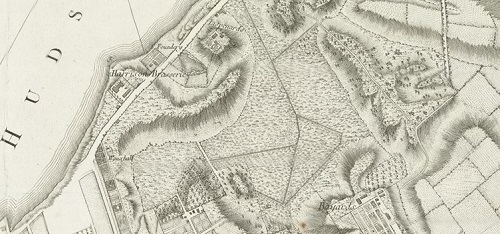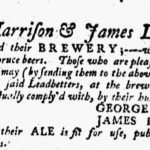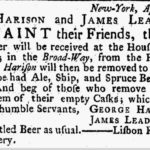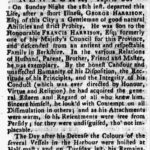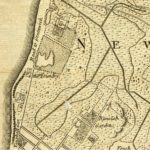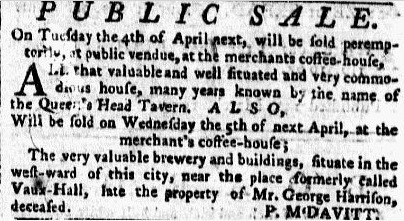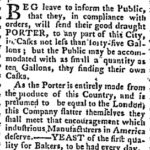 What a title. I have been trying to figure out how to move out of the cities of Albany and New York and figure out what is going on in the young state’s countryside after the American Revolution. As with today, a variety of factors cause how beer is and is not available. And a variety of factors which affect why Albany remains the center of brewing in New York for the next two or three generations. As always, it is not just about the great white male even if there are plenty around to take credit and, yes, to have some effect. To understand what happens as a matter of individual personal will, however, is to miss much of history.
What a title. I have been trying to figure out how to move out of the cities of Albany and New York and figure out what is going on in the young state’s countryside after the American Revolution. As with today, a variety of factors cause how beer is and is not available. And a variety of factors which affect why Albany remains the center of brewing in New York for the next two or three generations. As always, it is not just about the great white male even if there are plenty around to take credit and, yes, to have some effect. To understand what happens as a matter of individual personal will, however, is to miss much of history.
First, we need to consider a map. This is a detail of the 1796 map by John Reid showing western New York. It’s really large scale. Have a look around. Notice something? Not a lot of roads. Not a lot of towns. Not a lot of people even 13 years after the end of the Revolution. There are reasons for this. It was difficult to settle. There were treaties with the aboriginal population of the remaining Iroquois to settle. And there were residual colonial rights of the state of Massachusetts to play out as well. Beer needs people and, for the most part, beer drinking people were not there yet.
Next, you have to appreciate where people are showing up, their needs do not generally focus on access to beer. They are trying to survive on the frontier in accordance with how they show up in these newly acquired lands. Unlike with British held Upper Canada, settlement does not always happen in a controlled organized fashion. There are two competing approaches: Whig-theory colonization and Jeffersonian pioneers. Consider this description of the first Euro-Americans who arrive as pioneers at Ithaca, New York:
In the month of April, 1783, eleven men left Kingston, on the Hudson River, with two Delaware Indians for guides, to explore the country west of the Susquehanna, with the intention of securing a future home. They were a month or more thus employed, but returned without making a location. In April of the following year, three of their number, related to each other by marriage, Jacob Yaple, Isaac Dumond, and Peter Hinepaw, revisited the district previously explored Ind selected four hundred acres on lot No. 9-1, then in the county of Montgomery, of which the west line of Tioga Street in the village of Ithaca is now the western limit. Upon that part which was in the valley were several “Indian clearings,” being small patches from which the hazel and thorn bushes had been removed, and which had been cultivated after the manner of the Indians. It appears that for many years after the first settlement it was the custom for the whole neighborhood, extending several miles around, to avail themselves of these clearings on the Flat. Here they planted corn principally, thinking that it could not be raised upon the higher ground… The settlers, having planted their corn in these places, left it in the care of John Yaple, a younger brother of Jacob, and returned to bring their families, with whom they came back in September. They brought also a few articles of household furniture, farming utensils, and a number of hogs, sheep, cattle, and horses. The three families numbered twenty persons. A month was consumed in their journey to Owego, where there was a small settlement, and nineteen days from thence to Ithaca. The route pursued and the difficulties necessary to be overcome account for their slow progress. Between Owego and the head of Cayuga Lake was but a well-beaten Indian trail, along which the way had to be cleared through the forest. Arrived at their new home, they at once set to work to provide appropriate shelters for the several families…
And not only were these settlers focused on just making a living but they are likely illegal occupiers. They are occupying the lands before they have a right to be there. Look at the case of Seth Read. He shows up in Geneva, New York in 1790, makes an improper deal to buy lands from the Seneca and later, his time and money not offering return, has to move on further west into what is now Erie, Pennsylvania. Without title to the land you are not going to amass the capital to create infrastructure. Things like roads and mills. And schools and breweries. Compare this with the colonization efforts by those with proper claims to land title. A few years later to the north end of the next Finger Lake over, the settlement of Geneva, New York was described in 1797 as much more orderly and advanced:
Hence the road from Fort Schuyler, on the Mohawk River, to Genesee, from being, in the month of June, 1797, little better than an Indian path, was so far improved, that a stage started from Fort Schuyler on the 30th of September, and arrived at the hotel in Geneva, in the afternoon of the third day, with four passengers. This line of road having been established by law, not less than fifty families settled on it in the space of four months after it was opened. It now bids fair to be, in a few years, one continued settlement from Fort Schuyler to the Genesee River. All last winter two stages, one of them a mail stage, ran from Geneva and Canadarqua to Albany weekly. A wilderness changed, in so few years, to the comfortable residence of a numerous body of industrious people, who enjoy the comforts and conveniences of life in a degree superior to most parts of the United States, affords matter of curiosity to the intelligent traveller, and many respectable characters undertake the journey from no other motive. To them, therefore, it must be highly gratifying to find entertainment and accommodation equal to any thing of the kind in America. Very few places of the size now exceed Geneva, either as to the stile of the buildings, the beauty of the adjoining country, or valuable improvements. The number of sail-boats have greatly increased on the lake, and the sloop finds constant employment : and, in addition to their comforts, a person from Scotland has established, at Geneva, a very respectable brewery, which promises to destroy in the neighbourhood, the baneful use of spirituous liquors. The apple and peach orchards, left by the Indians, yield every year abundance of fruit, for the use of the inhabitants, besides making considerable cyder; so much so, that one farmer near Geneva sold cyder, this year, to the amount of one thousand two hundred dollars.
See that? One thousand two hundred bucks from cider? A fortune! And see that other thing? A brewery in 1797 in Geneva, New York. Half way between what is now Syracuse and Rochester. That’s the log cabin brewery that Lord Selkirk came across in 1803 and recorded in detail in his diary. Clear title to land and a road established by law. Things the true pioneer lack. The settlement at Geneva had another advantage. An early route to the sea. Before the road reached it, early Geneva sat on the lake. And the lake reached south. Have a look at the map again. Find Geneva and trace a line south. See the bottom of Seneca Lake? Look left a bit. See Mud Lake? See that branch of the Conhocton River reaching over to the north and east. Before the roads were there to move goods on land there was a route to get people and goods in and out that reached south. To the mighty Susquehanna and on to Baltimore.
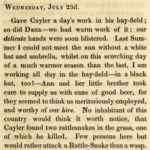 Click on that thimbnail. It’s an entry in the diary of John Maude from 23 July 1800. It describes a scene in a haying field near the Conhocton River, wild enough that its infested with rattlesnakes but settled enough that the locals are handy in dealing with them. And there is beer. Is that the route it took up there in red? The colonization of the Conhocton was a big effort that centered on a new town, Bath. It sought to create an estate in the old world style and it was based on the idea that a proper community needed a number of resources including beer. You may have noticed that there is no great city there today. The idea did not work out as planned. Bath never became more than a village and the surrounding area never became another Hudson Valley. But it does illustrate the way in which the civilization of beer first came to the frontier lands of New York, bringing the promise “to destroy in the neighbourhood, the baneful use of spirituous liquors.” Peace, population, law and investment. All preconditions to the establishment of a beer culture.
Click on that thimbnail. It’s an entry in the diary of John Maude from 23 July 1800. It describes a scene in a haying field near the Conhocton River, wild enough that its infested with rattlesnakes but settled enough that the locals are handy in dealing with them. And there is beer. Is that the route it took up there in red? The colonization of the Conhocton was a big effort that centered on a new town, Bath. It sought to create an estate in the old world style and it was based on the idea that a proper community needed a number of resources including beer. You may have noticed that there is no great city there today. The idea did not work out as planned. Bath never became more than a village and the surrounding area never became another Hudson Valley. But it does illustrate the way in which the civilization of beer first came to the frontier lands of New York, bringing the promise “to destroy in the neighbourhood, the baneful use of spirituous liquors.” Peace, population, law and investment. All preconditions to the establishment of a beer culture.
This is just a high level introduction. I am going to dig into New York state brewing in the 1790s, conclude the state of New York city brewing to the end of the 18th century and establish another foundation for the ascendancy of Albany in the first half of the 1800s. That will require looking at the Dutch estate properties, slavery, another early colonization effort at Cooperstown as well as the hovering menace of the British to the north. Piece of cake. Done by March. Easy peasy.




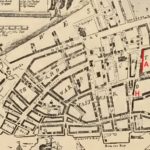

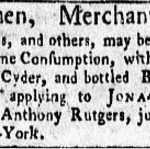

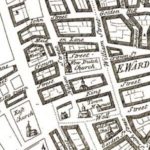



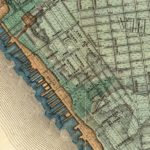

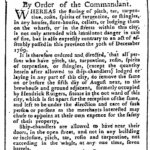


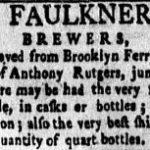


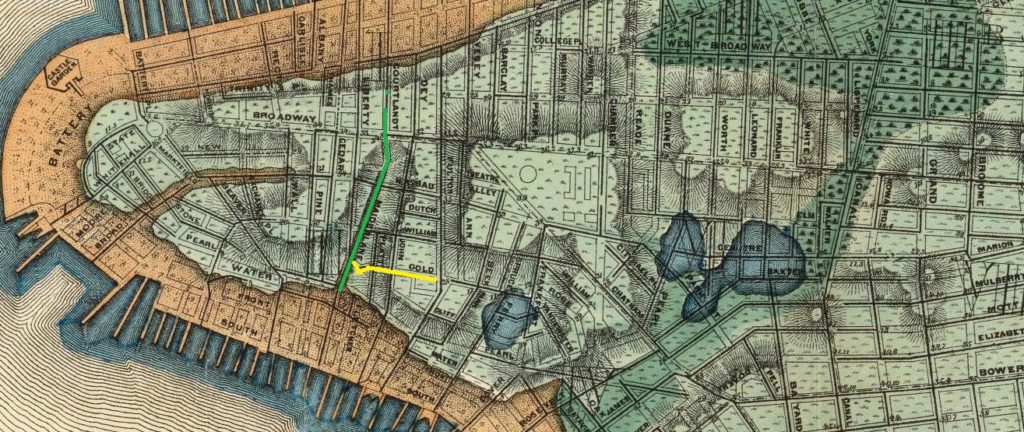


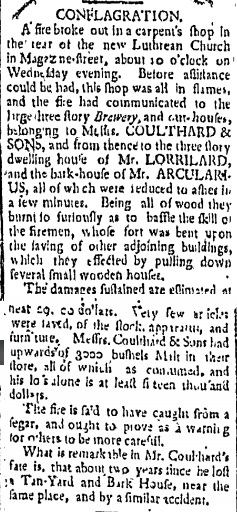 Anyway, the new brewery burned, too. I think they all burned, these old breweries. In the 1 July 1797 edition of Greenleaf’s New York Journal, right, it was reported that all the malt was lost and the whole business was a write off. An errant cigar at the nearby site of the new Lutheran Church apparently started it. He gets up and operating again as by July in 1806, his beers are being
Anyway, the new brewery burned, too. I think they all burned, these old breweries. In the 1 July 1797 edition of Greenleaf’s New York Journal, right, it was reported that all the malt was lost and the whole business was a write off. An errant cigar at the nearby site of the new Lutheran Church apparently started it. He gets up and operating again as by July in 1806, his beers are being 
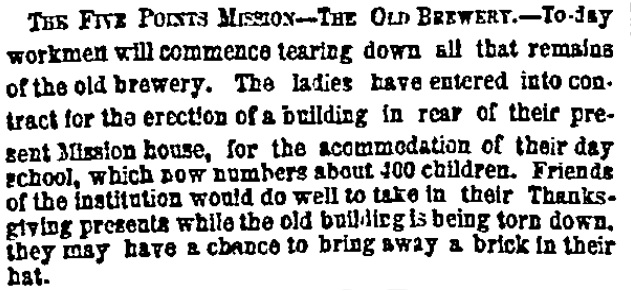
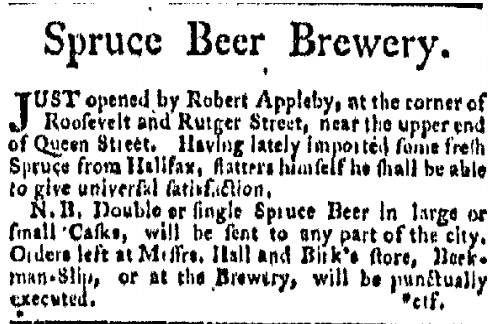
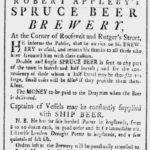
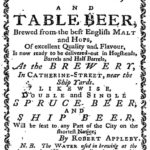


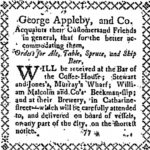
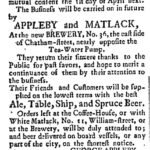
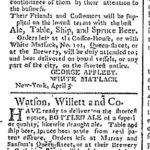
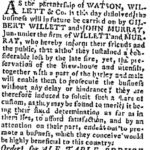



 Middagh Street is
Middagh Street is 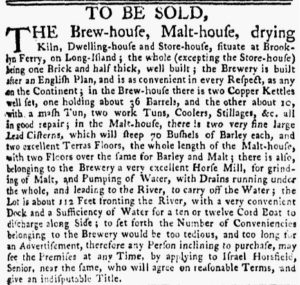 To the left you see something of the motherlode. The golden moment you dream of finding. It is the notice of the apparently unsuccessful sale of the brewery placed in the New York Mercury of
To the left you see something of the motherlode. The golden moment you dream of finding. It is the notice of the apparently unsuccessful sale of the brewery placed in the New York Mercury of 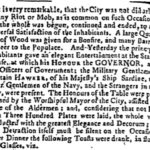
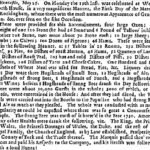
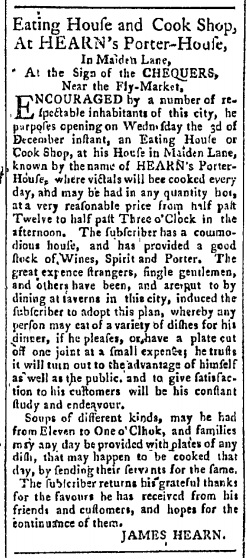

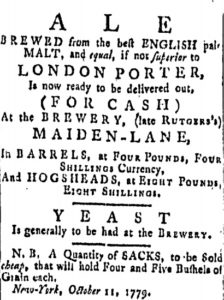 Jumping ahead, we find this ad from 1779 – the middle part of the war – which sets out some very interesting things. If you read it carefully, you will see it is not an ad for porter but an ad for a beer that is claimed to be as good as London’s porter. Imported porter is the standard to be met in the marketplace. The brewery is the
Jumping ahead, we find this ad from 1779 – the middle part of the war – which sets out some very interesting things. If you read it carefully, you will see it is not an ad for porter but an ad for a beer that is claimed to be as good as London’s porter. Imported porter is the standard to be met in the marketplace. The brewery is the 